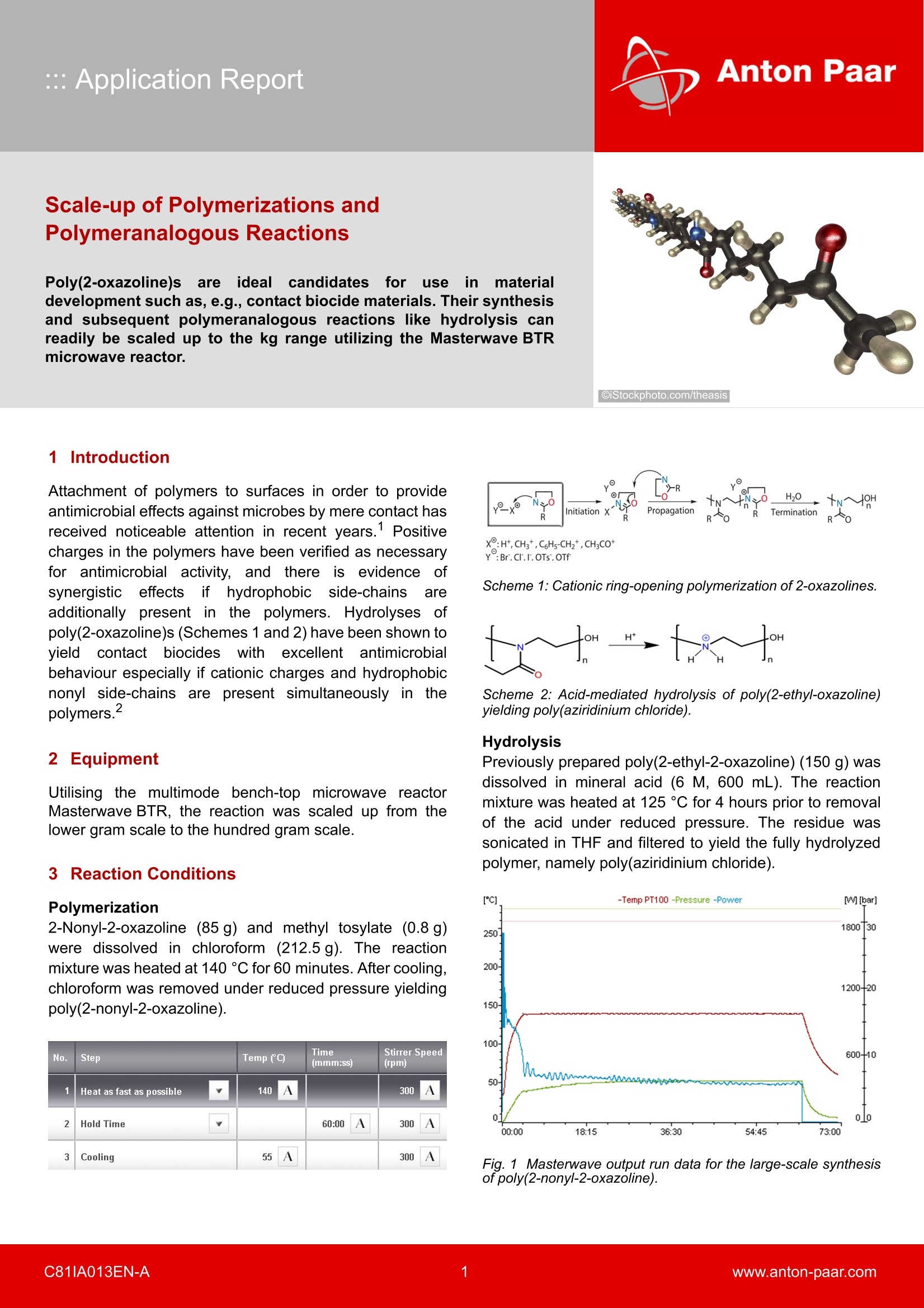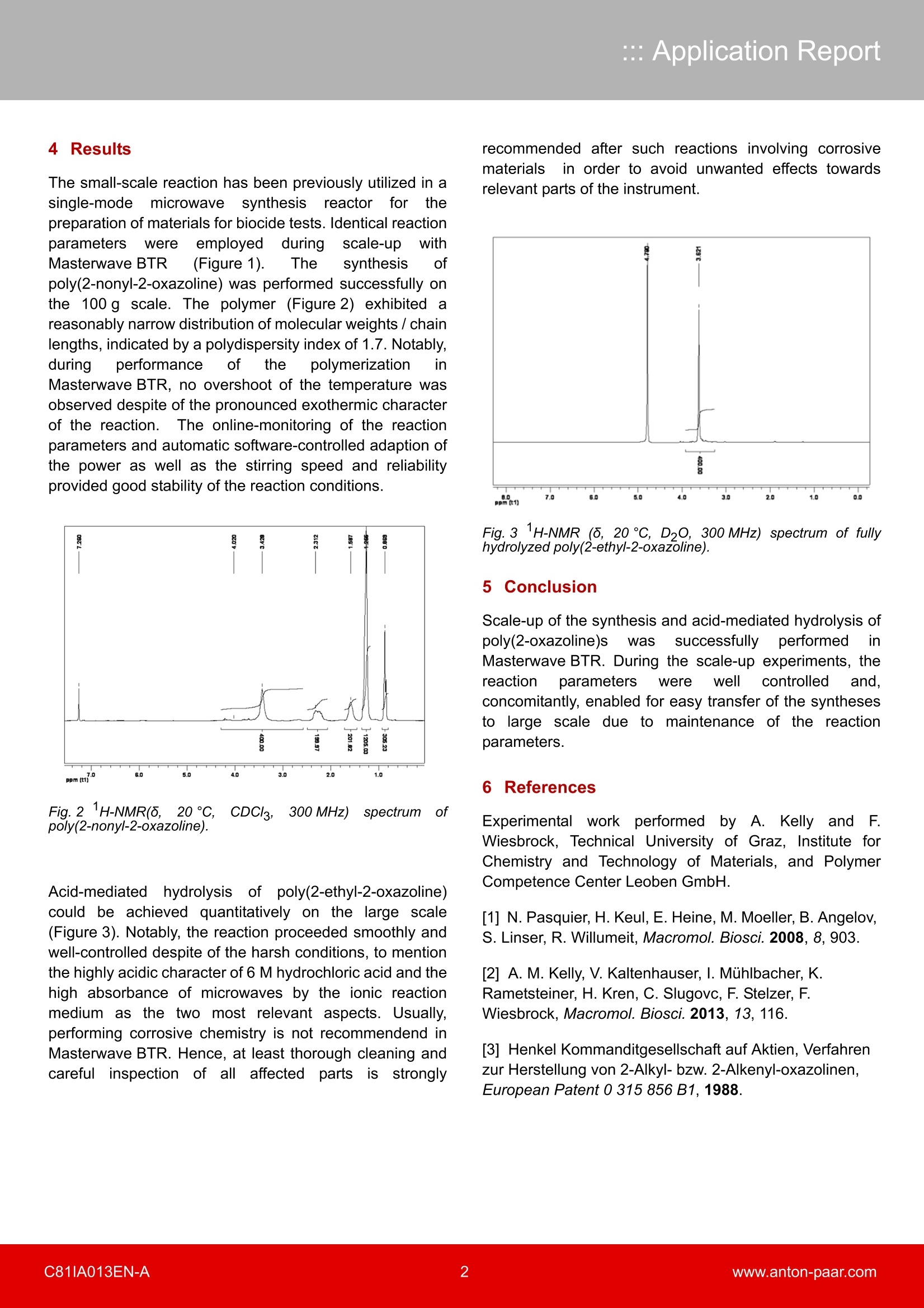聚合物附着在表面上以提供仅通过接触即可对微生物产生抗菌作用近年来受到了关注。 水解聚(2-恶唑啉)已显示出产生具有优异抗菌性能的接触式杀菌剂行为。
方案详情

::: Application Report Scale-up of Polymerizations and Polymeranalogous Reactions Poly(2-oxazoline)sareidealcandidates; for use: in materialdevelopment such as, e.g., contact biocide materials. Their synthesisand subsequent polymeranalogous reactions like hydrolysis canreadily be scaled up to the kg range utilizing the Masterwave BTRmicrowave reactor. Attachment of polymers to surfaces in order to provideantimicrobial effects against microbes by mere contact hasreceived noticeable attention in recent years. Positivecharges in the polymers have been verified as necessaryfor antimicrobial activity, and thereis evidence ofsynergistic; effects if hydrophobicside-chains areadditionallypresent in the polymers. Hydrolyses ofpoly(2-oxazoline)s (Schemes 1 and 2) have been shown toyield contact biocideswithexcellent antimicrobialbehaviour especially if cationic charges and hydrophobicnonyl side-chains arepresent simultaneously in thepolymers. 2 Equipment Utilising the multimode bench-top microwave reactorMasterwave BTR, the reaction was scaled up from thelowergram scale to the hundred gram scale. 3 Reaction Conditions Polymerization 2-Nonyl-2-oxazoline (85 g) and methyl tosylate (0.8 g)were dissolved in chloroform (212.5g). The reactionmixture was heated at 140°C for 60 minutes. After cooling,chloroform was removed under reduced pressure yieldingpoly(2-nonyl-2-oxazoline). No. Step Temp (C) Time (mmm:ss) Stirrer Speed(rpm) 1 Heat as fast as possible 140 300 2 Hold Time 60:00 A 300A 3 Cooling 55 A 300 A .0Y:Br,Cr.r.OTs,OTf x:H*,CH*,C6H5-CHz*,CH;CO+ Scheme 1: Cationic ring-opening polymerization of 2-oxazolines. Scheme 2: Acid-mediated hydrolysis of poly(2-ethyl-oxazoline)yielding poly(aziridinium chloride). Hydrolysis Previously prepared poly(2-ethyl-2-oxazoline) (150 g) wasdissolved in mineral acid (6 M, 600 mL). The reactionmixture was heated at 125°℃ for 4 hours prior to removalof the acid under reduced pressure. The residue wassonicated in THF and filtered to yield the fully hydrolyzedpolymer, namely poly(aziridinium chloride). Fig. 1 Masterwave output run data for the large-scale synthesisof poly(2-nonyl-2-oxazoline). The small-scale reaction has been previously utilized in asingle-mode microwavesynthesis reactor forr thepreparation of materials for biocide tests. Identical reactionparameters were employed during scale-up withMasterwave BTR (Figure 1). The synthesis ofpoly(2-nonyl-2-oxazoline) was performed successfully onthe 100 g scale. The polymer (Figure 2) exhibited areasonably narrow distribution of molecular weights / chainlengths, indicated by a polydispersity index of 1.7. Notably,during performance of the polymerization inMasterwave BTR, no overshoot of the temperature wasobserved despite of the pronounced exothermic characterof the reaction. The online-monitoring of the reactionparameters and automatic software-controlled adaption ofthe power as well as the stirring speed and reliabilityprovided good stability of the reaction conditions. Fig. 2'H-NMR(8,20 °C,CDCl3,300 MHz) spectrumofpoly(2-nonyl-2-oxazoline). Acid-mediatedhydrolysisof poly(2-ethyl-2-oxazoline)could be achieved quantitatively on the large scale(Figure 3). Notably, the reaction proceeded smoothly andwell-controlled despite of the harsh conditions, to mentionthe highly acidic character of 6 M hydrochloric acid and thehigh absorbance of microwaves by the ionic reactionmedium as the two most relevant aspects. Usually,performing corrosive chemistry is not recommendend inMasterwave BTR. Hence, at least thorough cleaning andcarefulinspection of allaffectedparts is strongly recommended after such reactions involving corrosivematerials in order to avoid unwanted effects towardsrelevant parts of the instrument. Fig. 3'H-NMR (8, 20℃, D2O, 300 MHz) spectrum of fullyhydrolyzed poly(2-ethyl-2-oxazoline). 5 Conclusion Scale-up of the synthesis and acid-mediated hydrolysis ofpoly(2-oxazoline)s was successfully performed inMasterwave BTR. During the scale-up experiments, thereaction parameters were well controlled and.concomitantly, enabled for easy transfer of the synthesesto large scale due to maintenance of the reactionparameters. 6 References Experimental 'workperformedby A. Kellyaand F.Wiesbrock, Technical University of Graz, Institute forChemistry and Technology of Materials, and PolymerCompetence Center Leoben GmbH. [1] N. Pasquier, H. Keul,E. Heine,M. Moeller, B. Angelov,S. Linser, R. Willumeit, Macromol. Biosci. 2008, 8, 903. [2] A. M. Kelly, V. Kaltenhauser, I. Muhlbacher, K.Rametsteiner, H. Kren, C. Slugovc, F. Stelzer, F.Wiesbrock, Macromol. Biosci. 2013, 13, 116. [3] Henkel Kommanditgesellschaft auf Aktien, Verfahrenzur Herstellung von 2-Alkyl-bzw. 2-Alkenyl-oxazolinen,European Patent 0 315 856 B1, 1988. AN-Awww.anton-paar.com 在Masterwave BTR中成功进行了规模扩大的合成和酸介导的聚(2-恶唑啉)水解反应。 在放大实验中,反应参数得到了很好的控制,并且由于维持了反应,因此易于将合成物大规模转移参数。
确定


还剩1页未读,是否继续阅读?
安东帕(上海)商贸有限公司为您提供《聚(2-恶唑啉)中放大聚合反应和水解检测方案(微波合成仪)》,该方案主要用于原料药中其他检测,参考标准--,《聚(2-恶唑啉)中放大聚合反应和水解检测方案(微波合成仪)》用到的仪器有
相关方案
更多
该厂商其他方案
更多









